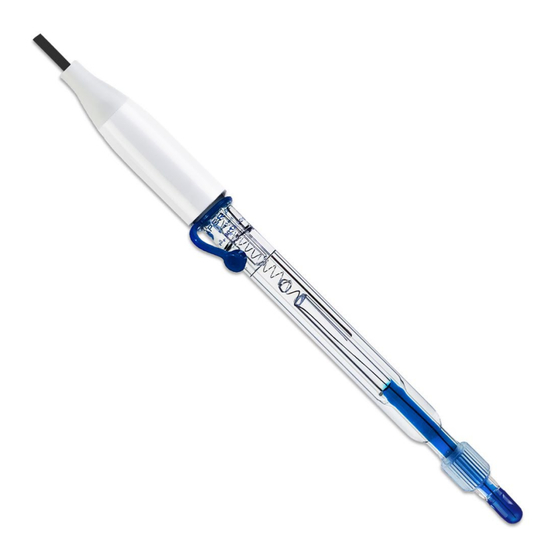Summary of Contents for Apera Instruments LabSen 871
- Page 1 ® LabSen 871 pH Electrode for Non-Aqueous Solutions and Organic Solvents User Manual...
-
Page 2: Table Of Contents
Table of Contents Brief Introduction ....................... 3 What’s in the Box ....................... 4 Technical Specifications ....................4 Preparation before Use ....................5 How to Measure ......................6 How to Clean the Electrode ..................7 How to Empty the Outer Bridge and/or Refill the Electrolyte ........8 Maintenance ...................... -
Page 3: Brief Introduction
1. Brief Introduction Built with proprietary sensor technology and premium materials from Switzerland, Apera LabSen 871 Glass-body pH Electrode is made for pH measurements of organic solvents such as Methanol, Ethanol, isopropanol, DMSO, Acetonitrile, etc. Main Features • The robust PHY sensitive membrane effectively protects the membrane's hydrated gel layer from damage by organic solvents and maintains sensitivity to the hydrogen ion response. -
Page 4: What's In The Box
2. What’s in the Box Content Quantity LabSen 871 pH Electrode 3M KCl Solution (50 mL) 1M LiCl Solution (50 mL) Extra Storage Vial for Sample Measurement Syringe Adjustment Tube User Manual 3. Technical Specifications Measuring Range 1 - 13 pH Temperature Range 0 - 80 °C... -
Page 5: Preparation Before Use
4. Preparation before Use 4.1 The LabSen 871 pH electrode is for non-aqueous organic solvents’ pH measurement. If measuring aqueous solutions, please choose another suitable pH electrode. It is normal for this pH electrode to have a 30-60 mV deviation in electric potential compared to conventional pH electrodes, which can be eliminated by performing 2 to 3 points of calibration. -
Page 6: How To Measure
5. How to Measure 5.1 Measure in water-miscible organic solvents (e.g. methanol, ethanol, ISPA) 5.1.1 Make sure to use 1M LiCl as the electrolyte in LabSen 871 pH electrode. 5.1.2 Transfer your sample solution to an empty sample storage vial and twist it onto the electrode tight (see Graph-4). -
Page 7: How To Clean The Electrode
5.2 Measure in water-immiscible organic solvents (e.g. hexane, chloroform, toluene, etc.) 5.2.1 Replace the electrolyte to 3M KCl in LabSen 871 pH electrode. 5.2.2 Take the sample of water-immiscible organic solvents and deionized water in a separating funnel and mix vigorously. The ratio of the organic solvent sample to water can be 1:1 or as per specified method. -
Page 8: How To Empty The Outer Bridge And/Or Refill The Electrolyte
6.2 After measurement in water-miscible organic solvents (e.g. methanol, ethanol, ISPA, etc.), you can choose to clean it directly with distilled or deionized water. Use a soft brush to remove the contaminants if necessary. 6.3 After measurement in water-immiscible organic solvents (e.g. hexane, chloroform, toluene, etc.), the electrode can be cleaned with ethanol, toluene, or acetone. -
Page 9: Maintenance
Graph-5 Graph-6 7.2 Use a syringe to add in pure water through the refilling hole to rinse off the outer bridge, pull up the movable sleeve again to accelerate the water outflow. 7.3 To refill new electrolyte, rinse the outer bridge first with the appropriate new electrolyte and empty the outer bridge (refer to Section 7.2.1). -
Page 10: How To Adjust The Movable Sleeve
solution (SKU: AI1107). Rinse off the vial and replace the soaking solution if it’s contaminated or insufficient. The electrode should never be stored in pure water such as deionized or distilled water. 8.2 The connector of the electrode should be kept clean and dry. If contaminated, please clean it with medical cotton and isopropyl alcohol and blow-dry it to prevent short circuit of the electrode or slow response of the electrode. -
Page 11: Limited Warranty
10. Limited Warranty We warrant this electrode to be free from defects in material and workmanship and agree to repair or replace free of charge, at option of APERA INSTRUMENTS, LLC, any malfunctioned or damaged product attributable to responsibility of APERA INSTRUMENTS, LLC for a period of SIX MONTHS from the delivery. - Page 12 APERA INSTRUMENTS, LLC Address: 6656 Busch Blvd, Columbus, OH 43229 Phone: 1-614-285-3080 Website: Email: info@aperainst.com aperainst.com...


















Need help?
Do you have a question about the LabSen 871 and is the answer not in the manual?
Questions and answers